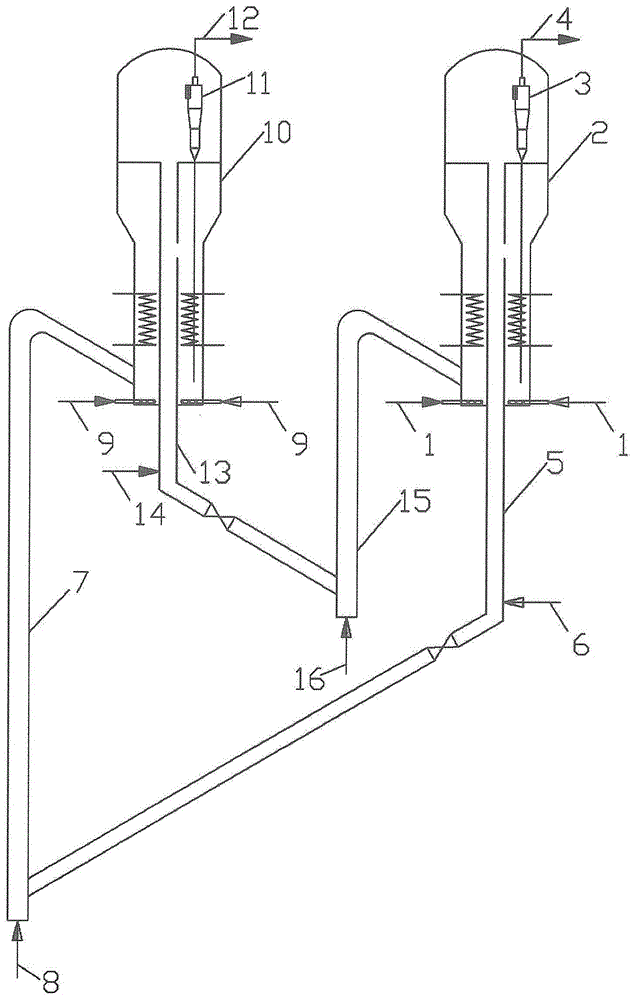Method for preparing low-carbon olefins by using oxygen-containing compounds
A technology of low-carbon olefins and compounds, which is applied in the direction of producing hydrocarbons from oxygen-containing organic compounds, hydrocarbon cracking, chemical instruments and methods, etc., can solve the problem of low yield of low-carbon olefins, so as to improve yield and optimize energy The effect of distribution and utilization
- Summary
- Abstract
- Description
- Claims
- Application Information
AI Technical Summary
Problems solved by technology
Method used
Image
Examples
Embodiment 1
[0069] In the dense-phase fluidized bed reactor, there is one secondary pre-coking zone and three secondary reaction zones, and in the dense-phase fluidized bed regenerator, there are four secondary regeneration zones. Hydrocarbons above C4 enter the first secondary carbon pre-deposition zone in the dense-phase fluidized bed reactor, contact with the fully regenerated catalyst, and convert them into products including low-carbon olefins. At the same time, the amount of carbon deposition on the catalyst reaches At a certain value, a pre-carbon deposition catalyst is formed, and the pre-carbon deposition catalyst enters the reaction zone; raw materials containing oxygenated compounds enter the first to third secondary reaction zones in the dense-phase fluidized bed reactor in parallel, and the pre-carbon deposition Catalysts pass through the first to third secondary reaction zones sequentially in series, and the feedstock containing oxygenates is contacted with the pre-deposited ...
Embodiment 2
[0071]One secondary pre-carbon deposition area and two secondary reaction areas are set in the dense-phase fluidized bed reactor, and two secondary regeneration areas are set in the dense-phase fluidized bed regenerator. Catalysts above C4 enter the first secondary carbon deposit zone in the dense-phase fluidized bed reactor, contact with the fully regenerated catalyst, and convert them into products including low-carbon olefins. At the same time, the amount of carbon deposit on the catalyst reaches At a certain value, a pre-carbon deposition catalyst is formed, and the pre-carbon deposition catalyst enters the reaction zone; raw materials containing oxygenated compounds enter the first to second secondary reaction zones in the dense-phase fluidized bed reactor in parallel, and the pre-carbon deposition Catalysts pass through the first to second secondary reaction zones sequentially in series, and the feedstock containing oxygenates is contacted with the pre-deposited carbon ca...
Embodiment 3
[0073] A dense-phase fluidized bed reactor is provided with 1 secondary pre-carbon deposition zone and 5 secondary reaction zones, and a dense-phase fluidized bed regenerator is provided with 5 secondary regeneration zones. After mixing naphtha and hydrocarbons above C4, it enters the first secondary pre-coking zone in the dense-phase fluidized bed reactor, contacts with a fully regenerated catalyst, and converts it into products including low-carbon olefins. At the same time, the catalyst When the amount of carbon deposit reaches a certain value, a pre-carbon deposit catalyst is formed, and the pre-carbon deposit catalyst enters the reaction zone; raw materials containing oxygenated compounds enter the first to fifth secondary reaction zones in the dense-phase fluidized bed reactor in parallel At the same time, the pre-coke catalyst passes through the first to fifth secondary reaction zones sequentially in series, and the feedstock containing oxygenates contacts with the pre-c...
PUM
 Login to View More
Login to View More Abstract
Description
Claims
Application Information
 Login to View More
Login to View More - R&D
- Intellectual Property
- Life Sciences
- Materials
- Tech Scout
- Unparalleled Data Quality
- Higher Quality Content
- 60% Fewer Hallucinations
Browse by: Latest US Patents, China's latest patents, Technical Efficacy Thesaurus, Application Domain, Technology Topic, Popular Technical Reports.
© 2025 PatSnap. All rights reserved.Legal|Privacy policy|Modern Slavery Act Transparency Statement|Sitemap|About US| Contact US: help@patsnap.com



